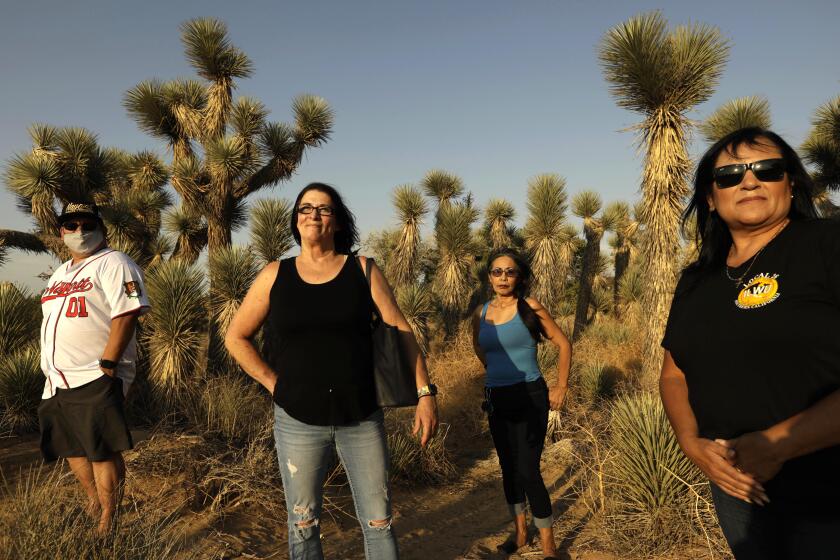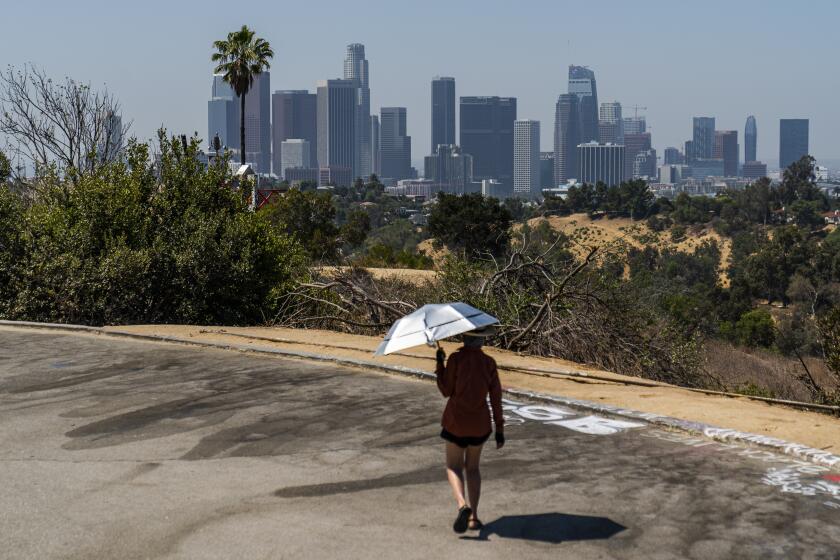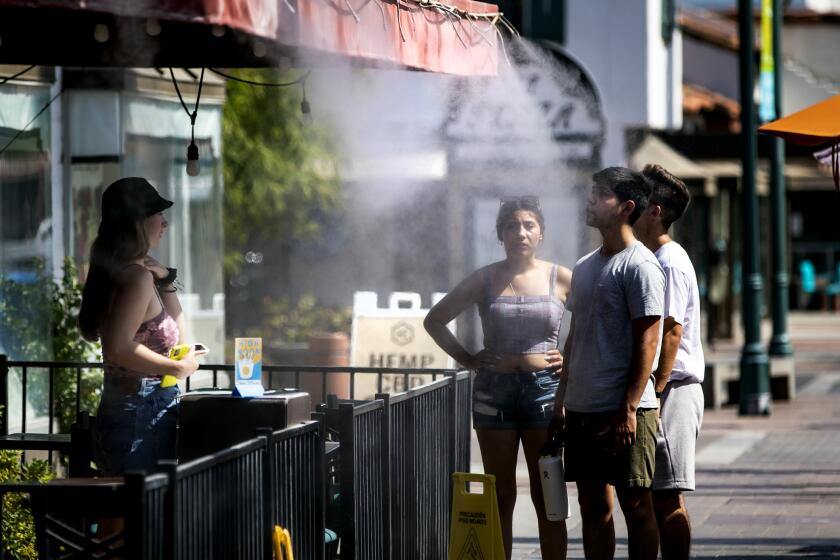‘All I can think about is the sun’: How workers are coping with California’s heat wave
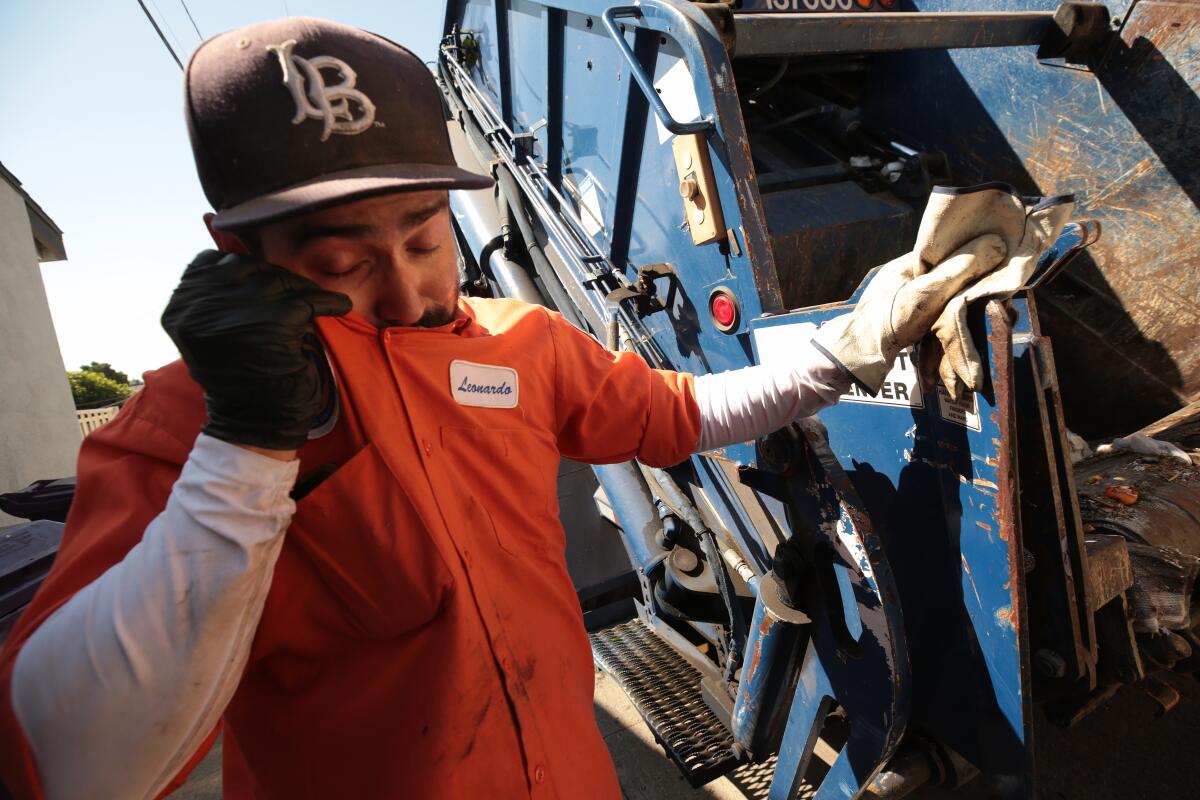
- Share via
A delivery driver relies on 15 bottles of water to get him through his route. A beekeeper keeps a portable fan under her veil. A construction worker starts as early as 6 a.m. but still ends the day with a sweat-soaked shirt.
This week’s triple-digit heat has pounded workers across Southern California, particularly those who labor primarily outdoors or whose workplaces, like many warehouses, lack air conditioning. It’s yet another way that climate change is contributing to inequality, and it is only going to get worse.
For the record:
6:08 p.m. Sept. 2, 2022An earlier version of this article quoted beekeeper Robin Jones as saying it takes 5,000 flowers to produce a gallon of honey. Jones later said the correct figure is 2 million flowers per gallon.
“We’re seeing temperatures increase; we’re seeing heat waves become more common,” said Amir Jina, an assistant professor at the University of Chicago’s Harris School of Public Policy who researches how environmental change affects societal development. This is an effect “less borne by the person in the high-paying job in an air-conditioned office” and more by those in lower-income jobs, such as warehouse workers and delivery drivers.
“This is not a problem equally felt across society,” he said.
Extreme heat takes a toll on output, limiting how long people are able to work and how effectively they can perform their jobs.
Extreme heat is endangering California warehouse workers, who often labor without air conditioning.
It also threatens their health. From 1992 to 2017, about 815 U.S. workers died of heat stress, according to the Bureau of Labor Statistics. More than 70,000 were injured.
For workers in marginalized groups, the effects of intense heat waves are magnified by preexisting disparities in health and environmental safety, said Michael Méndez, an assistant professor studying environmental policy and justice in UC Irvine’s department of urban planning and public policy. “You add another layer, an extreme weather event, and they experience a triple burden of impact,” he said.
California is among the states to establish standards for heat exposure, requiring employers to provide access to fresh water and shade, as well as training about heat illness prevention and planning. At a Los Angeles news conference Tuesday, union members, U.S. Sen. Alex Padilla (D-Calif.) and Rep. Judy Chu (D-Monterey Park) advocated for the passage of legislation mandating federal workplace protections against heat stress.
“It hasn’t yet been internalized by people that when the workforce isn’t healthy, when the workforce isn’t productive ... that’s not just affecting them and their well-being, it’s also affecting your business, your productivity,” Jina said.
The Times interviewed six workers who had to work in this week’s extreme temperatures about what it has been like and how they’ve tried to keep cool.
Leonardo Zamudio, sanitation worker
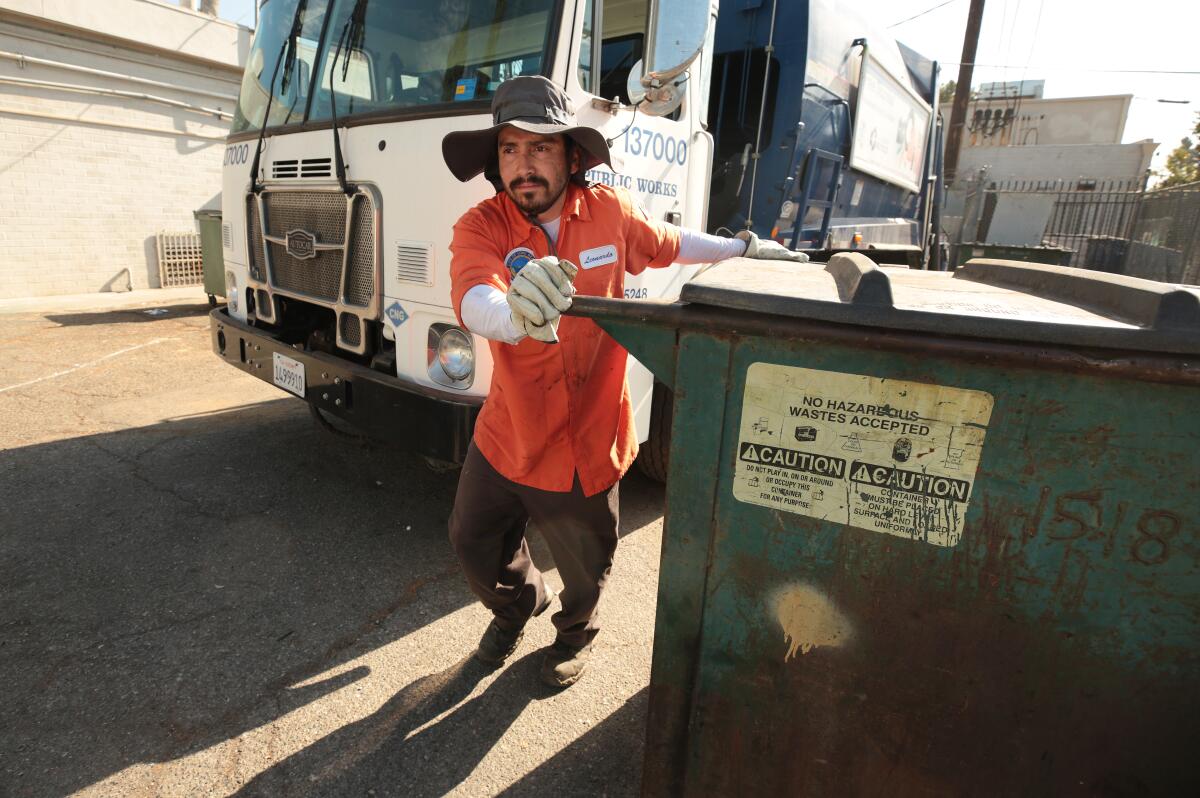
Leonardo Zamudio operates what he calls an “old school” garbage truck for the city of Long Beach.
There’s no automated arm, no twiddling of a joystick from an air-conditioned truck cabin. For each bin of steaming trash Zamudio collects, he has to climb out and manually lug the can to the truck. Then he hooks it onto the arms — called “tippers” — attached to the back of the truck, pushes up a lever and dumps in the contents.
In theory, Zamudio said, sanitation workers should be able to stay somewhat cool when they’re in the cabin between stops. But not every truck he operates has working air conditioning. In the mornings, he tests the A/C system: If it fails his informal inspection, he makes sure to file a report. He said he reported his truck earlier this week after finding that it was not cooling down properly.
Even with functioning air conditioning for much of the last week, the work has been difficult, said Zamudio, 31.
All the climbing in and out and walking around to the back means Zamudio gets a blast of the hot air that streams out of the truck while the engine is running. He walks a lot — up to eight miles a day — retrieving trash bins from deep in alleys and behind commercial businesses, he said.
“All I can think about is how the sun feels on my body, on my face, on my skin,” Zamudio said. “I try to focus on what I’m doing. Sometimes I make mistakes when [the heat is] starting to get too much. That’s when I know I need to stop for a minute.”
He’ll signal to his partner that he needs a break. They’ll get their water, take a swig, then head back out into the hot air.
After a day of collecting garbage in sweltering temperatures, Zamudio has no energy, he said.
“I miss out on just catching up with my family, because all I want to do is lay in the room with A/C and take naps,” he said.
Robin Jones, beekeeper
As the heat wave began Wednesday morning, beekeeper Robin Jones headed to one of her hives on a Hollywood rooftop.
“It might be 90 out there, but on the roof, it’s 120,” said Jones, 47.
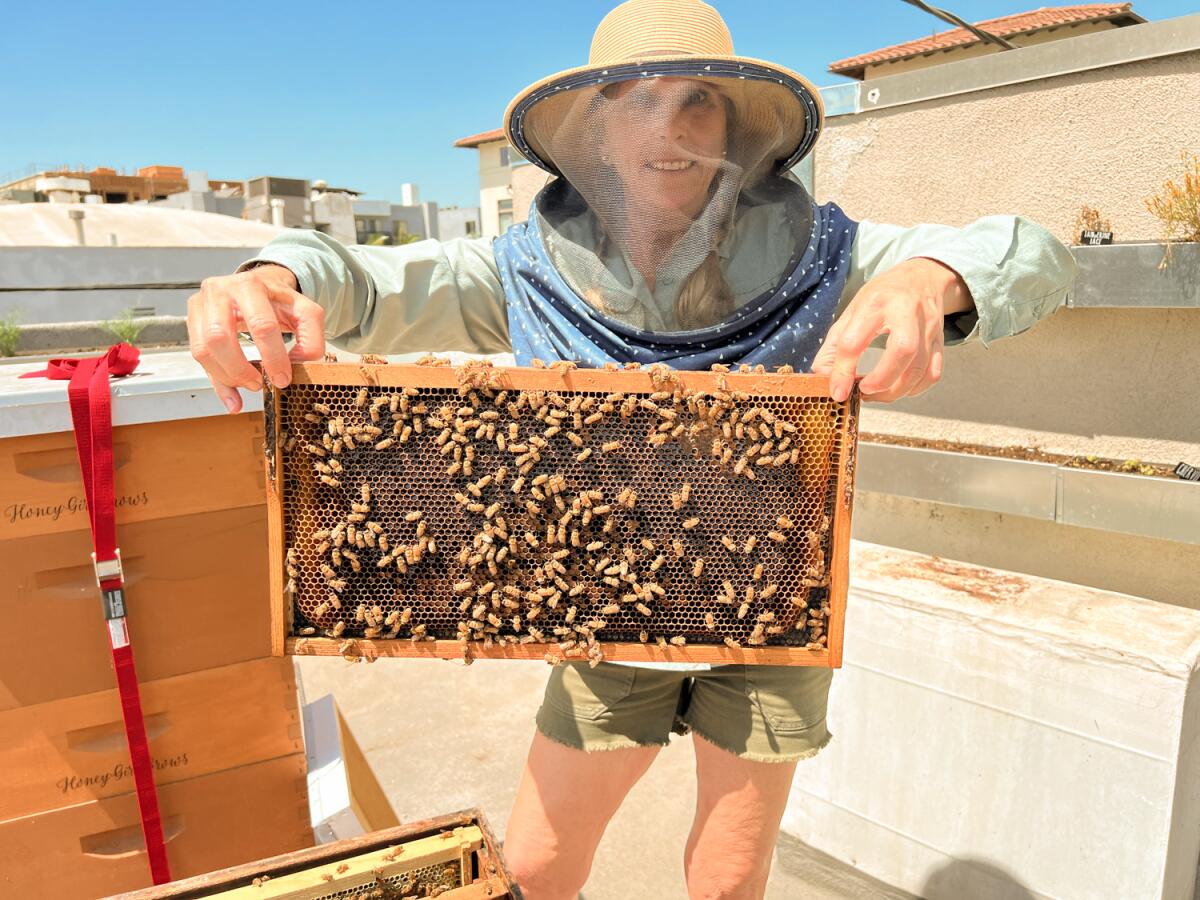
Jones has an arsenal of strategies to handle the heat when covered head to toe in her heavy beekeeper’s suit. She wears a portable fan under her veil, a wet scarf around her neck and — if it’s really bad — a frozen water bladder on her back that cools her off as it thaws. To hydrate, she drinks unflavored Pedialyte.
She has broken out in hives — the other kind — three times from the heat.
On Wednesday, she started her day around 8 a.m. Any earlier would’ve been risky, said Jones, a beekeeper of 15 years.
“You want more bees off to work when you open a hive and pull out the honey,” she said. “You don’t want everybody home paying attention to you.”
As the sun rose, Jones harvested five gallons of honey from the hives she installed as part of a rooftop garden for the celebrated restaurant Providence, which grows delicacies such as oyster leaves and edible flowers. A single gallon of honey requires the nectar of about 2 million flowers, Jones said. Her company, Honey Girl Grows, designs, installs and tends gardens for restaurants and corporations, as well as residential projects.
“When you feel that first tickle of sweat, you think, ‘Is something in your suit?’ Then all of a sudden, you feel it pouring down your spine,” Jones said. “There is no boob sweat like a beekeeper’s boob sweat.”
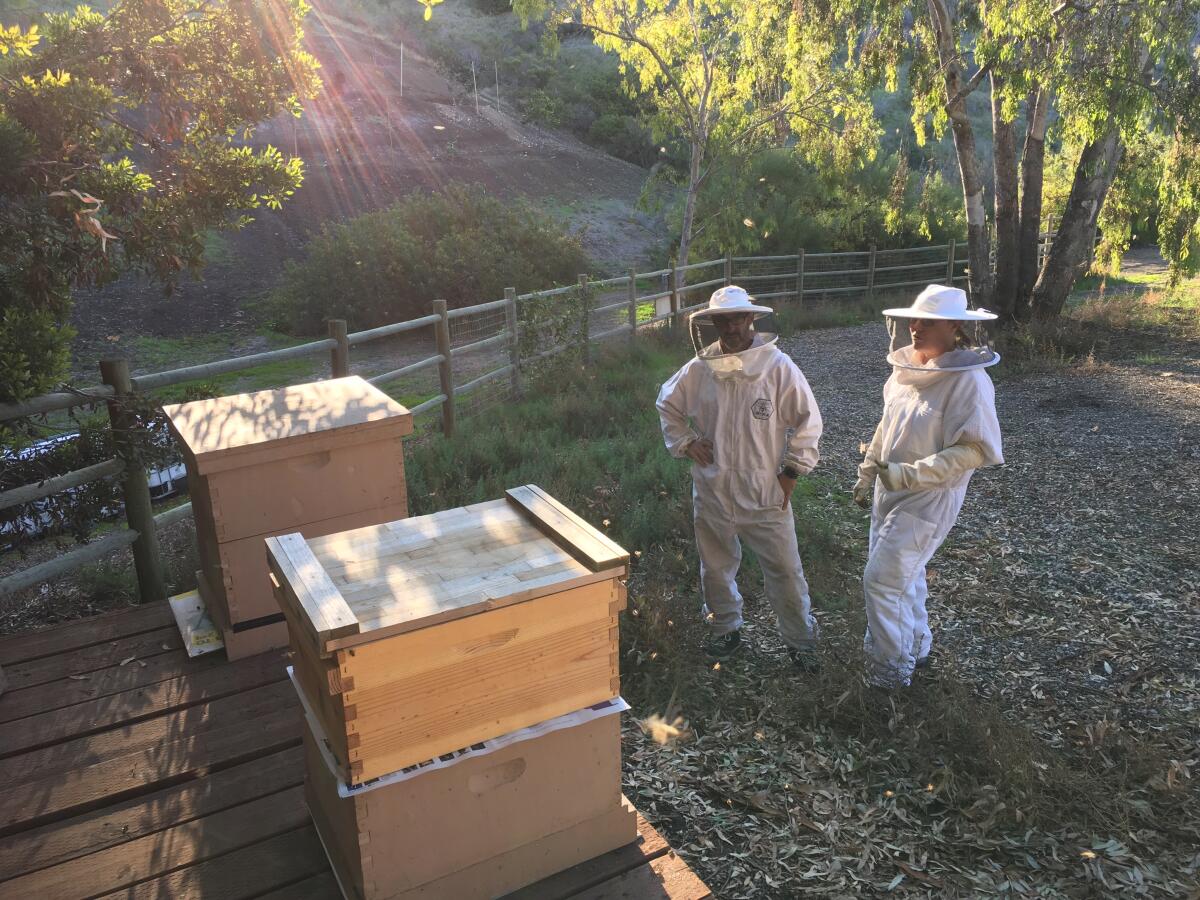
Later that afternoon, at the hottest time of the day, Jones donned her full beekeeping suit to tend to a hive of “very defensive” bees on a rooftop in Venice. She duct-taped the ankles of her pants, closing off any entrance points. She put on two pairs of neoprene gloves, which gather pools of sweat inside but have their place: When you get stung, Jones said, the outer pair can be peeled off quickly to reduce contact with venom.
“Beekeeping suits are like mini saunas, but the Venice rooftop view is nice!” she said.
Saul Rubio, construction worker
At 7 a.m., the temperature had already climbed above 80 degrees in Monrovia, and Saul Rubio, 50, was taking his first break from screwing sheet rock panels onto the walls of a five-story hotel under construction at Myrtle Avenue and Huntington Drive.
A construction worker with 30 years of experience, he has never worked in such an oppressive heat wave, he said. It’s hard enough lifting 50-pound panels of sheet rock while wearing a 6-pound tool belt, but when the temperatures reach triple digits, Rubio longs for winter, he said.
“Winter is much easier — cooler,” he said in Spanish.
Experts remind Southern California residents to stay hydrated, stay out of the direct sun and shelter in air conditioned buildings, if possible.
The uniform offers no mercy during heat waves: Everyone on the job site wears a hard hat, a neon-orange safety vest over a long-sleeve shirt, long pants and heavy work boots, preferably with steel-toe protection. The air is filled with the cacophony of pounding hammers and morning traffic.
To help the workers cope with the heat, the construction company that’s building the 109-room hotel adjusted the hours: The crew starts as early as 6 a.m. and works until 2 p.m., with lots of breaks in between. In cooler weather, the shifts can begin as late as 8 a.m. At the start of a recent shift, the foreman dispatched a worker to buy bags of ice to cool the water bottles stored in an ice chest inside a metal storage container.
Rubio said the crew members catch a small break when they work in the indoor shade, where they keep a 10-gallon cooler of water. He can’t guess how much water he drinks a day, but he finishes each shift with his shirt soaking wet.
“I go home, take off my wet shirt and put on a dry one and relax,” he said, knowing he will drench another shirt the next day.
Juan Rojas, delivery driver
Beads of sweat formed on Juan Rojas’ face as he trudged down a street on his Hollywood route, arms filled with packages. It was noon on Wednesday, the beginning of what forecasters expect to be California’s longest and most intense heat wave of the year, and Rojas, 28, had too many deliveries to make.
The blue-and-black reflective vest Rojas wore marked him as a delivery driver for Amazon. He said he had more than 200 packages stacked in a gray Amazon-branded van, precariously parked on the narrow road some 30 yards behind him.
“Our dispatch will ask, ‘Hey, why are your drivers taking forever?’ But you know, sometimes it’s hard for us to deliver to a customer — to get inside a building,” Rojas said. “Drivers, they get hurt, because they gotta rush everything.”
Rojas said he was lucky that day: His van had air conditioning. Usually, he drives bigger trucks, which often don’t.
“It’s hard to look for packages inside” the big trucks, Rojas said. “Outside could be like 90 degrees. Inside, it’s going to be like 100 and something, probably could reach 120.”
Another heat wave is sweeping the Southland, and residents are asked to conserve power during a statewide flex alert. Here’s what you need to know.
Rojas said he recently has been making sure to pack at least 15 bottles of water. It’s normal for him to finish all of the 16-ounce bottles by the end of the day. Sometimes, he has to do a grocery run to buy more mid-shift.
When it’s hot, Rojas tries to take his time.
“I tend to go slow. Because even though I have water, sometimes you just are overworking your body,” he said.
Saalika Khan, production assistant
It was around noon and 103 degrees when Saalika Khan nearly passed out. She was working as a production assistant on a set in Sylmar, for a scene in a convenience store.

Khan, 32, said she ran around all morning on the hot asphalt of the parking lot, propping up tents and setting up chairs for the actors.
When she bent to pick up two more plastic folding chairs, it hit her. She stumbled and dropped the chairs, her vision went blurry, and she started gagging. On the ground, her hands burned on the asphalt, she said.
The set’s medic asked if he could call an ambulance, and when Khan said no, he had her sit in the corner of a tent for two hours, she said.
“He was like, ‘You gotta keep drinking tons and tons of water,’ so I was downing several bottles of water periodically.”
Khan said the medic told her she was the second person to need medical attention on the set; the other was one of the production’s truck drivers. Khan declined to identify the company shooting the commercial and other details of the project because she signed a nondisclosure agreement as part of her contract.
She called her mom from the medic’s tent, and together they decided she should not work Thursday and Friday, when she was supposed to be on set in Ontario and in Northridge, where temperatures were projected to reach nearly 110 degrees.
She said she couldn’t afford to forgo the $250 a day she was making, and she didn’t want supervisors to think she was weak and decide not to hire her for future projects. In the end, she said, she did not feel well enough to work. Khan spent Thursday holed up in her apartment chugging Suero, an electrolyte drink recommended for hydrating after working in heat-intensive environments.
Khan said she’s been thinking a lot about the effects of climate change. She was born in Karachi, Pakistan, which has been ravaged in recent weeks by record-breaking flooding that has killed more than 1,000 people and displaced millions. She has some extended family in Pakistan, but they don’t live in the hardest-hit areas.
“I’m living comfortably, safely in America — you know, relatively safe, compared to like, you know, what’s going on there,” she said. Pakistan is “getting the brunt of it right now, but it’s coming for us all. ... Climate change is serious. It’s only going to get hotter.”
Teodosio Villegas, garment worker
Boiling steam from the industrial ironing machines Teodosio Villegas operates on garment factory floors is dangerous enough. Combined with sweatshop-like conditions and Los Angeles’ August heat, there is no relief, he said.
Villegas said he burned his arm in early August because his ironing machine wasn’t working properly. That same week, he said, a worker operating the machine directly behind him blew steam that burned the skin on his back.

Many garment factories in downtown Los Angeles are known for suffocating conditions year-round: small shuttered windows, locked doors, ambient heat from equipment and no air conditioning, with workers pressured to produce at fast paces.
Villegas said a factory at Pico Boulevard and Maple Avenue, where he worked last week, was no different. “Everyone was sweating. My clothes were soaking wet,” he said.
Very rarely do Villegas’ bosses provide drinking water, he said. When water is available, it’s usually roach-infested, with a yellow tint and a dirty, unchanged filter, he said. He and other workers typically bring their own jugs of water, which eats about $1.75 from the $75 he takes home on an average day.
He said he confronted his manager last week about the heat, showing his card indicating his membership with the Garment Worker Center, a group that provides resources and services to apparel workers in downtown L.A. “It didn’t help,” Villegas said. “He made an angry face. He looked very upset.”
Villegas said he thinks that’s why he hasn’t been assigned work since then, and he is worried that he has not earned money for several days.
Asked what measures he takes to mitigate the summer heat, Villegas said he does nothing. “We work like this because of necessity,” he said. “I just deal with it.”
More to Read
Inside the business of entertainment
The Wide Shot brings you news, analysis and insights on everything from streaming wars to production — and what it all means for the future.
You may occasionally receive promotional content from the Los Angeles Times.
